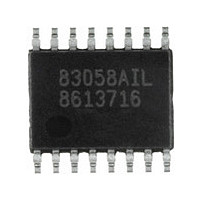IDTICS83058AGILF IDT, Integrated Device Technology Inc, IDTICS83058AGILF Datasheet - Page 7

IDTICS83058AGILF
Manufacturer Part Number
IDTICS83058AGILF
Description
Manufacturer
IDT, Integrated Device Technology Inc
Type
Clock Multiplexerr
Datasheet
1.IDTICS83058AGILF.pdf
(14 pages)
Specifications of IDTICS83058AGILF
Number Of Clock Inputs
8
Mode Of Operation
Single-Ended
Output Frequency
250MHz
Output Logic Level
LVCMOS/LVTTL
Operating Supply Voltage (min)
2.375V
Operating Supply Voltage (typ)
2.5/3.3V
Operating Supply Voltage (max)
3.465V
Package Type
TSSOP
Operating Temp Range
-40C to 85C
Operating Temperature Classification
Industrial
Signal Type
LVCMOS/LVTTL
Mounting
Surface Mount
Pin Count
16
Lead Free Status / RoHS Status
Compliant
IDT
The spectral purity in a band at a specific offset from the
fundamental compared to the power of the fundamental is called
the dBc Phase Noise. This value is normally expressed using a
Phase noise plot and is most often the specified plot in many
applications. Phase noise is defined as the ratio of the noise power
present in a 1Hz band at a specified offset from the fundamental
frequency to the power value of the fundamental. This ratio is
expressed in decibels (dBm) or a ratio of the power in the 1Hz
As with most timing specifications, phase noise measurements
has issues relatings to the limitations of the equipment. Often
the noise floor of the equipment is higher than the noise floor of
ICS83058I
8:1, SINGLE-ENDED MULTIPLEXER
™
/ ICS
™
8:1, SINGLE-ENDED MULTIPLEXER
O
A
FFSET
DDITIVE
F
ROM
P
C
HASE
ARRIER
7
band to the power in the fundamental. When the required offset
is specified, the phase noise is called a dBc value, which simply
means dBm at a specified offset from the fundamental. By
investigating jitter in the frequency domain, we get a better
understanding of its effects on the desired application over the
entire time record of the signal. It is mathematically possible to
calculate an expected bit error rate given a phase noise plot.
the device. This is illustrated above. The device meets the noise
floor of what is shown, but can actually be lower. The phase noise
is dependent on the input source and measurement equipment.
F
J
REQUENCY
ITTER
Additive Phase Jitter
(H
(12kHz to 20MHz) = 0.19ps typical
Z
)
ICS83058AGI REV. C OCTOBER 23, 2008
@ 155.52MHz















